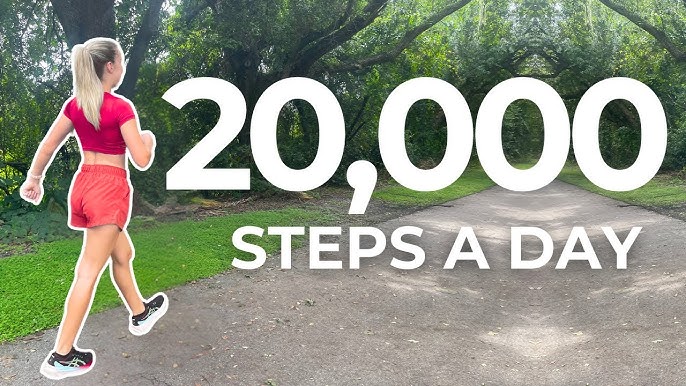20,000 steps equal 8.5 to 10 miles (13.5 to 16 km) for most adults. The exact distance depends on stride length, body height, and walking speed. Walking this amount usually requires 2.5 to 4 hours.

Understanding Step Length:
Definition:
Step length is the distance between two successive heel strikes of opposite feet. It is the main factor that converts steps into distance.
Average Values:
-
Average male stride: 0.75–0.78 m (2.46–2.56 ft).
-
Average female stride: 0.68–0.70 m (2.23–2.30 ft).
-
Brisk pace adds 5–10% to stride length.
How Far Is 20,000 Steps in Miles and Kilometers?
Conversion Formula:
-
Miles = (Steps × Stride length in feet) ÷ 5,280.
-
Kilometers = (Steps × Stride length in meters) ÷ 1,000.
Distance Table:
| Step Count | Distance (Short stride 2.2 ft) | Distance (Average stride 2.4 ft) | Distance (Long stride 2.5 ft) |
|---|---|---|---|
| 5,000 | 2.08 miles | 2.27 miles | 2.37 miles |
| 10,000 | 4.16 miles | 4.55 miles | 4.73 miles |
| 15,000 | 6.25 miles | 6.82 miles | 7.10 miles |
| 20,000 | 8.33 miles | 9.09 miles | 9.47 miles |
Time Required to Complete 20,000 Steps:
Walking Speed vs. Duration:
-
3.0 mph pace → 3 hr 50 min.
-
3.5 mph pace → 3 hr 20 min.
-
4.0 mph pace → 3 hr 0 min.
-
4.5 mph pace → 2 hr 40 min.
Factors That Extend Time:
-
Uneven terrain.
-
Frequent stops.
-
Inclined routes.
Calories Burned in 20,000 Steps:
Estimated Burn by Body Weight:
-
55 kg (121 lbs) → ~600 kcal.
-
70 kg (154 lbs) → ~800 kcal.
-
85 kg (187 lbs) → ~1,000 kcal.
Additional Influences:
-
Uphill walking increases burn by 15–20%.
-
Carrying weight raises total energy use.
Practical Lists for Walkers:
Best Situations to Walk 20,000 Steps:
-
Training for endurance sports.
-
Active commuting in large cities.
-
Hiking or outdoor exploration.
-
Weight loss goals with higher activity demand.
Challenges of 20,000 Steps Daily:
-
Time commitment of 3–4 hours.
-
Increased risk of joint strain.
-
Need for adequate hydration and footwear.
-
Infeasibility with sedentary work schedules.
How to Measure Your Own Stride Length:
Simple Home Method:
-
Mark a 20-ft path.
-
Walk naturally and count steps.
-
Divide distance by step count.
-
Multiply stride by 20,000 for personal distance.
Device Calibration:
-
Update height and weight in watch settings.
-
Walk a measured track for GPS adjustment.
-
Re-calibrate monthly for accuracy.
Contextual Examples of 20,000 Steps:
Geographic Equivalents:
-
Equal to walking the full length of Manhattan Island.
-
Equal to Heathrow Airport to Tower Bridge in London.
-
Equal to two-thirds of the Boston Marathon.
Occupational Equivalents:
-
Nurses complete ~12,000 steps per shift.
-
Postal workers average 15,000+ steps.
-
20,000 steps aligns with high-activity professions.
FAQs: How Far Is 20,000 Steps?
Q1. How far is 20,000 steps for a short person?
For a person 5’2″ (157 cm) with 0.65 m stride, 20,000 steps ≈ 13 km (8.1 miles).
Q2. How far is 20,000 steps for a tall person?
For a person 6’2″ (188 cm) with 0.80 m stride, 20,000 steps ≈ 16 km (9.9 miles).
Q3. How long does it take to walk 20,000 steps on a treadmill?
At 4 mph speed, it requires 3 hours with no breaks.
Q4. Is walking 20,000 steps daily healthy?
It burns 600–1,000 kcal and supports cardiovascular fitness, but excessive repetition risks overuse injuries.
Q5. How does 20,000 steps compare to recommended activity levels?
WHO recommends 150 minutes of moderate activity weekly, equal to ~7,500 steps daily, making 20,000 steps more than double the basic target.
Q6. Why does my tracker show fewer miles?
Trackers estimate stride length; calibration errors reduce accuracy.
Q7. How many laps around a football field is 20,000 steps?
A 105-m field equals ~140 steps; 20,000 steps = 143 laps.
Learn More: Coolant and Distilled Water: The Complete Automotive Guide
What Time Does Burger King Serve Lunch?
Conclusion:
20,000 steps equal 8.5 to 10 miles (13.5 to 16 km). This distance requires 2.5 to 4 hours of walking and expends 600–1,000 kcal depending on body weight. Distance varies by stride, speed, and terrain. While 20,000 steps provide superior fitness benefits, most health improvements occur at lower step counts such as 7,500 to 10,000.

